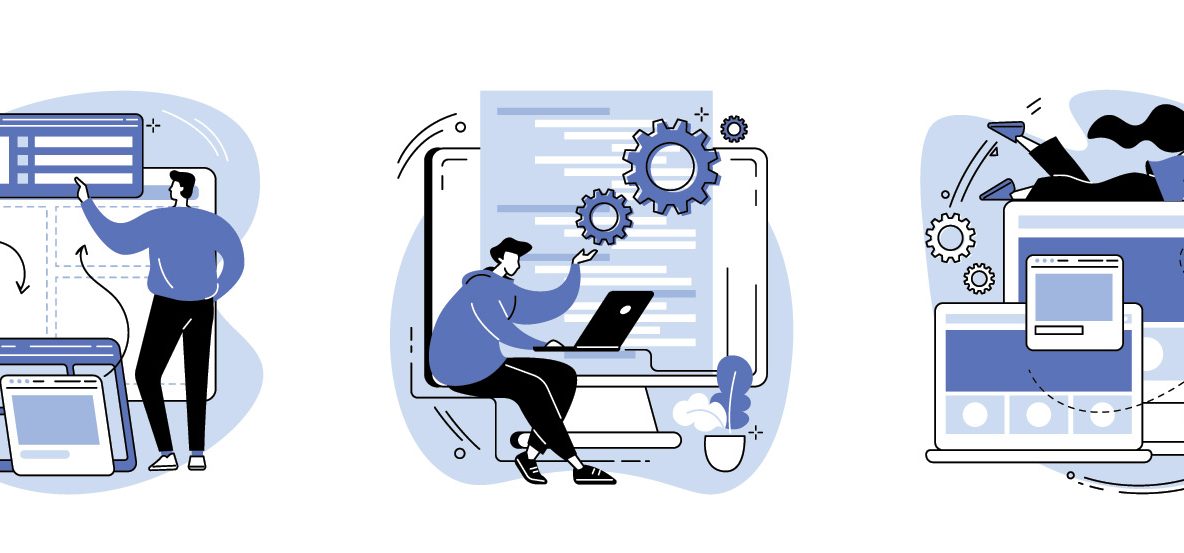
What Is Front-End and Back-End Web Development?
Web development is a broad term that refers to taking an idea and turning it into a fully functional website or app. The two types of web development are front-end and back-end.
In this post, we’ll define what both types mean, explain their differences, and share how they complement each other for your website or app development project.
What Is Front-End Web Development?
Front-end web development refers to the implementation of a design.
The goal of front-end developers is to provide users with a seamless experience of browsing through your site or app. The more comfortable users are with clicking on links and scrolling down your app, the longer they’ll use it.
Below are the languages most commonly used by front-end developers:
- HTML: Standard markup language used to provide structure to your web pages.
- CSS: Helps provide style and flair on top of your HTML code.
- JavaScript: Gives developers the ability to create custom (often interactive) functionalities within web browsers.
Here are the primary responsibilities of front-end web developers:
Create an application that meets UX/UI standards
Using their knowledge of various programming languages, front-end developers are responsible for coding the page templates.
At the same time, they must style the page to capture the appearance and feel of the site as mandated by their brand guidelines or the guidelines set by a UI designer.
QA testing
The QA team’s organization handles the tasks under this responsibility. However, there are times when the front-end developer is the one who ensures that all site elements requiring user input, e.g., forms and checkout pages, are validated.
For example, if the site asks for the user’s personal details to proceed with their purchase, the site must be able to properly process the information and send the order summary to the customer for confirmation.
If there are issues with these pages and processes, the developer must fix them as soon as possible to launch the site properly.
Optimize for speed to satisfy users and search engines
Speed and efficiency are part of front-end developers’ responsibilities based on two viewpoints, both of which happen to share a common objective.
From a user’s perspective, they want a site that is not only easy to use but also loads fast.
According to Pingdom, a site that loads longer than five seconds will have almost 40% of its initial visitors leave the site.
Source: Pingdom
From an SEO point of view, decreasing your site’s loading time affects its ability to rank on organic search.
Site speed has been a ranking factor since 2018, while Core Web Vitals (CWV) was just minted as one in May 2021. Therefore, if you want to generate more organic traffic to your site, your developer must make your site load as fast as possible.
There are many ways developers can improve site speed, such as moving to a dedicated server, compressing image file sizes, and more.
What Is Back-End Web Development?
Back-end development is the work that goes into managing web application logic on the server side of things. It’s an essential part of web design because it makes sure your site works on all platforms (e.g., Mac, Windows, Linux) and allows people to use it without any issues.
A lot of web developers work on a “LAMP” platform, which stands for:
- Linux (open source operating system): Solves complex problems like server administration and data storage. It can also be used for deploying applications in the cloud.
- Apache (web server): Saves you time by allowing you to install new features quickly. However, it’s not the only web server back-end developers use. An alternative to the Apache is Nginx, which is a more popular choice among high-traffic websites. Amazon Web Services (AWS), on the other hand, offers multiple cloud services in a single platform.
- MySQL (Database management system): Allows you to store and organize information. Other popular database management systems include Redis (has the fastest caching of any other system), MongoDB (schema-less database), and PostgreSQL (performance and scalability), to name a few.
- PHP (scripting language): Responsible for server-side scripting for collecting data, producing dynamic page content, communicating with the database to fetch data to return to the browser, and more.
At the same time, back-end developers are using other languages that primarily consist of the following:
- Python: A flexible and powerful easy-to-use language for developing web frameworks and applications.
- Go: A minimalist language with a simple interface and has a reasonable learning curve even for non-developers.
- Java: An object-oriented language that allows you to reuse the code in other programs.
- Ruby on Rails: A language that uses a model-view-controller (MVC) architecture for stability and predictability. It allows you to easily modify the code or add new features to your site or app.
- .NET (C#, F#, or VisualBasic): Another object-oriented language that comes with the Microsoft Visual Studio Integrated Development Environment (IDE).
With these languages in mind, below are the responsibilities of a back-end web developer:
Write highly efficient code
Back-end developers must first discuss with business owners what their technical requirements for their website are. From there, the developers must write code that meets those requirements using the appropriate languages.
Build and maintain system architecture
The code must result in data that front-end users of the website can interact and engage with. A perfect example is the development of payment processing systems used in e-commerce sites.
More importantly, the developer must be able to maintain the business logic for the code to successfully interact with users.
Network security and protection
Your site’s servers can incur malicious attacks from online threats. Without the right protection, the attacker could easily collect customer data that will put their identities, as well as your credibility, at risk.
Therefore, to ensure the safety and security of your site or app, the back-end developer must put security measures in place. In any case, protecting and recovering your web properties will be much easier with the developer’s help.
For instance, back-end developers must consider updating to private cloud services, as many large enterprises and SMEs rely on this hosting service for security.
The Difference Between Front-End and Back-End Web Development
A front-end developer’s main objective is to develop and create a website so that it walks the line between beauty and function, from the fonts it uses to its loading speed. A back-end web developer, on the other hand, creates tools and scripts that manipulate data for future use by a website.
Front-end web development is about making sure the website looks good and that its features work properly. It’s all about design, layout, and functionality. Back-end developers, on the other hand, deal with code that runs on the server with the logic that ensures the appropriate interaction and data exchange between client and server.
Why You Need Both Types of Developers for Your Project
From their descriptions alone, it is evident that they play different roles in the development process. Front-end developers focus on developing how a website looks, while back-end developers build its functionality and what it does. However, both types of developers are necessary to create a new website and make it work correctly.
That said, your business can benefit from working together on the same project. For example, front-end development is greatly enriched by having back-end’s support through servers, languages, and frameworks that allow for increased functionality. At the same time, back-end developers need front-end design skills to build an aesthetically pleasing site or application.
In short, unless you’re developing a static site or an API, you cannot have one without the other!
For example, let’s say you’re building a web application that requires an API to function and interact with third-party apps.
Below is a scenario where both developers work in unison to create a fully functioning website:
- Front-end developers document desired behaviors of APIs: The front-end development team needs to provide a list of APIs they would like from back-end developers to clear all expectations before any code has been written. In addition, the team must include documentation on desired behaviors for each endpoint, such as expected input data format or output responses, if available, when creating their “wish list.”
- Have back-end developers review the wish list for APIs: The front-end team will submit the requests for certain API functionalities to the back-end team, who will determine whether the recommendations are possible or not. Even if the API requests are reasonable, there’s no reason to move forward if the back-end team thinks implementing them will be impossible or slow. However, instead of rejecting the request outright, they should propose more plausible alternatives to perform the same purpose as the requested feature.
- Implement their code to the agreed-upon APIs and test: This is where having both development teams will help your business tremendously. First, both sides will work on the code for testing to see if the API can interact with other apps according to their desired features. From here, they can verify which ones are working correctly and which ones aren’t.
- Apply iterations: After identifying the faulty APIs, both teams will go back to working on the code and brainstorm for alternatives until they find a solution that works.
With this workflow, it should be evident that having both development teams working on your side will ensure the success of your web application.
Conclusion
As different as front-end and back-end web developers are, both are vital for your website or application. Their complementary skills and responsibilities allow you to build a website or application with your audience in mind.
Having them design a highly intuitive and secure web application that works on all levels allows you to grow your business and scale effectively.
So, if you have to choose between a front-end or a back-end web developer, always settle for both.



